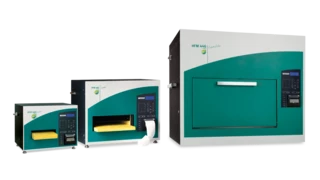methods
Heat Flow Meter (HFM)
based on ASTM C518, ASTM C1784, ISO 8301, JIS A1412, DIN EN 12664, and DIN EN 12667
In a heat flow meter (HFM), the test specimen is placed between two heated plates controlled to a user-defined mean sample temperature and temperature drop to measure heat flowing through the specimen. The sample thickness (L) corresponds to the actual sample dimension or to match the desired thickness of a compressible sample. The heat flow (Q) through the sample is measured by two calibrated heat flux transducers covering a large area of both sides of the specimen.
After reaching a thermal equilibrium, the test is done. The heat flux transducer output is calibrated with a standard. For the calculation of the Thermal ConductivityThermal conductivity (λ with the unit W/(m•K)) describes the transport of energy – in the form of heat – through a body of mass as the result of a temperature gradient (see fig. 1). According to the second law of thermodynamics, heat always flows in the direction of the lower temperature.thermal conductivity (λ) the average heat flux and the thermal resistance R is used, in accordance with Fourier’s Law (see formulas on the right). The thermal transmittance, also known as U-value, is the reciprocal of the total thermal resistance. The lower the U-value, the better the insulating ability.
